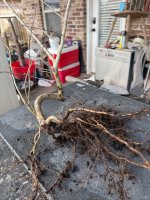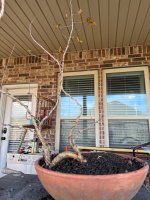Thank you!Yes, and yes. I think you're talking to the right people. That inverse taper in the root end up looking like an onion bulb. Best case you have feeder roots coming out of it. Worst case feeder roots are much farther down. In either case cut at the base of that reverse taper and you usually get new roots there.
You are using an out of date browser. It may not display this or other websites correctly.
You should upgrade or use an alternative browser.
You should upgrade or use an alternative browser.
The 2025 Yamadori/Collecting Thread
- Thread starter Cajunrider
- Start date
Cruiser
Omono
Nursewood Sitka spruce.



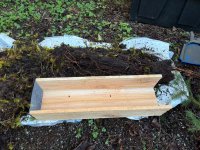


This tree will come to represent the form of a forest spruce/hemlock that established on a high-cut stump. Its long snaking roots made their way through rotting wood into the ground below. As the stump disintegrated the tree may have become unstable and slumped over.
Something in the spirit of these..but as a cascade maybe.
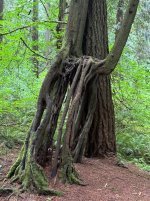

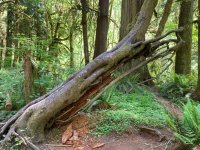






This tree will come to represent the form of a forest spruce/hemlock that established on a high-cut stump. Its long snaking roots made their way through rotting wood into the ground below. As the stump disintegrated the tree may have become unstable and slumped over.
Something in the spirit of these..but as a cascade maybe.



JesseKane
Yamadori
Question for Rocky Mountain collectors out there, how do y'all time your collecting of RMJ in the spring? Just wait until the ground is thawed enough to easily dig? Or do you use a plant indication such as foliage starting to green up?
ShadyStump
Imperial Masterpiece
The general rule for deciduous is to wait until buds start swelling, but ideally before they open at all.Question for Rocky Mountain collectors out there, how do y'all time your collecting of RMJ in the spring? Just wait until the ground is thawed enough to easily dig? Or do you use a plant indication such as foliage starting to green up?
Conifers can be trickier to tell that, though. Yes, ground thaw, but it needs to stay thawed even over night. It'll be hard for you tell in Denver because the urban heat island effect in the metro strip tempers the extreme temp swings you should naturally see. Color returning is also a useful indicator, but it can start coming back as soon ambient freezes are over, but the ground is still cold enough to hold the tree dormant.
It really is a matter of just spending enough time out there to learn how to tell. It's not like this in other places, but our geology makes everything about collecting yamadori extra tricky, so timing becomes important in order to mitigate that
JesseKane
Yamadori
So beginning of the window opens up with persistent ground thaw, got it. Is that to ensure that the tree has broken dormancy before collection, allowing the tree to use the stored energy from fall to heal roots? It would then follow that the end of the collection window would be when new growth starts pushing as that root healing energy is now going into foliage.The general rule for deciduous is to wait until buds start swelling, but ideally before they open at all.
Conifers can be trickier to tell that, though. Yes, ground thaw, but it needs to stay thawed even over night. It'll be hard for you tell in Denver because the urban heat island effect in the metro strip tempers the extreme temp swings you should naturally see. Color returning is also a useful indicator, but it can start coming back as soon ambient freezes are over, but the ground is still cold enough to hold the tree dormant.
It really is a matter of just spending enough time out there to learn how to tell. It's not like this in other places, but our geology makes everything about collecting yamadori extra tricky, so timing becomes important in order to mitigate that
The areas I've scouted are a couple hours into the mountains, so environment temps will be close to normal. Of course that means that there's every chance I'll have to make a couple test trips to the area to build knowledge on seasonal changes for that specific spot as things warm up. But hey, I'll be itching for mountain time by then!
BrianBay9
Masterpiece
My first indicator was when the fire roads were passable
ShadyStump
Imperial Masterpiece
Close, but not necessarily. Again, just like deciduous, as the new buds start to swell is ideal. It's just not always easy to tell on juniperus. Native conifers can handle the extreme swings we can get in the spring better than deciduous, so there's a wider range of time, but they often don't handle root disturbance as well.end of the collection window would be when new growth starts pushing as that root healing energy is now going into foliage.
Also, it's important to remember just how trees grow. The growth hormones responsible for root growth are created in the new foliage growth and sent down to the roots in the cambium layer under the bark. Conversely, the hormones that push foliage are produced in the new root tips and sent up through the sapwood. The trunk stores carbon for the organism, while the roots store carbohydrates and other nutrients.
You'll notice as you track this thread and sometimes after root pruning that often (but not always) trees will show stunted foliage growth after a severe root reduction.
ABSOLUTELY, NO EXCEPTIONS let the tree recover AT LEAST a year with no work at all! Just water and feed, in a temp-stable space.. And leave plenty of room for new root growth in whatever container. You're not going to want to go straight to a fancy pot. There's a reason you see them go into wooden boxes, baskets, just about anything else that's more ideal for root growth.
kollman
Seed
Did my first (urban) yamadori today. Someone needed to get rid of their juniper bushes in Los Angeles so I figured I’d try my hand at it.
Sprayed the roots before bagging it, then built my box and planted it in a mix of pumice, akadama, potting soil, and some sphagnum on top because I was all out of soil. I haven’t given it a proper watering yet, just been spraying the roots and soil and covered with a bag. Keeping it in a generally shaded spot
Any tips moving forward for best chance of survival? Anything I should’ve done differently to this point? Thanks
Sprayed the roots before bagging it, then built my box and planted it in a mix of pumice, akadama, potting soil, and some sphagnum on top because I was all out of soil. I haven’t given it a proper watering yet, just been spraying the roots and soil and covered with a bag. Keeping it in a generally shaded spot
Any tips moving forward for best chance of survival? Anything I should’ve done differently to this point? Thanks
Attachments
The Barber
Chumono
My toolkit for collecting trees must haves are:
-A metal detecting shovel. They are compact, the heads are more narrow, and they are solid steel. Generally they are a perfect walking cane length also which I find handy. They are made to be sharpened, and will glide through the smaller roots if they are.
-A good sawzall with upgraded batteries with bigger mHa so they last longer.
-Cellophane wand/dispensers, new to my toolkit, but holds a rootball together so much better than a plastic bag as it form fits.
-A folding hand saw. I buy mine from Harbor freight, I swear they last longer and clog less than the more expensive ones I have owned. I keep meaning to buy a folding handle that you can put sawzall blades into, seen them before and seems like a great option.
-Pruner/lopper makes removing branches and roots easier.
-A metal detecting shovel. They are compact, the heads are more narrow, and they are solid steel. Generally they are a perfect walking cane length also which I find handy. They are made to be sharpened, and will glide through the smaller roots if they are.
-A good sawzall with upgraded batteries with bigger mHa so they last longer.
-Cellophane wand/dispensers, new to my toolkit, but holds a rootball together so much better than a plastic bag as it form fits.
-A folding hand saw. I buy mine from Harbor freight, I swear they last longer and clog less than the more expensive ones I have owned. I keep meaning to buy a folding handle that you can put sawzall blades into, seen them before and seems like a great option.
-Pruner/lopper makes removing branches and roots easier.
Applicative
Mame
Applicative
Mame
Cedar elm
and the trunk with movement is a mystery at the moment.
The cedar elm is from this grove of really unique looking highly ramified ones. I'm not sure why this one particular spot has such specific features - lichen all over it as well.
and the trunk with movement is a mystery at the moment.
The cedar elm is from this grove of really unique looking highly ramified ones. I'm not sure why this one particular spot has such specific features - lichen all over it as well.
Attachments
bonsaiwood
Shohin
Gabler
Masterpiece
Any privet fans? Did some tree pruning at my grandmother’s place this weekend and dug up this little 2-footer. They grow like weeds in her yard. I have chopped others down to stumps and they always come right back in spring.
View attachment 580637
View attachment 580638
I've recently started finding invasive privets at my parents' place. They're supposed to he good bonsai material. Most weedy shrubs make decent bonsai.
These 2 olives were planted in half whiskey barrels along a street I walk several times a week. One was never watered and the second one was always in 4" of water. I reached out to the owners several times, finally they sent me a text with approval to remove the plants. No hesitation.
Olive 1 had a nice healthy root system but almost completely without any leaves. Nice base, several nice thick trunks. We'll see how they respond to proper treatment. Planted a few days ago in pure pumice in a quickly made box.
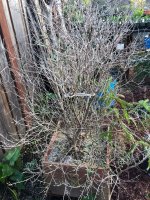
Olive 2 was saturated for months at a time.
Roots are shot, but there is still green under the bark so we'll see how it grows if at all. The base is very nice, a possible fix might be to cut off the roots and "root it".
'

Olive 1 had a nice healthy root system but almost completely without any leaves. Nice base, several nice thick trunks. We'll see how they respond to proper treatment. Planted a few days ago in pure pumice in a quickly made box.

Olive 2 was saturated for months at a time.
Roots are shot, but there is still green under the bark so we'll see how it grows if at all. The base is very nice, a possible fix might be to cut off the roots and "root it".
'

Attachments
Oddly_Aude
Mame
There's been a random tree growing from beneath my front porch that I had to remove. It somehow grew taller than me despite all it's branches being in darkness minus one. Its taken me months, but I finally tugged it out today. 

 honestly, I have no idea if it will make it. But I figure I might as well try.
honestly, I have no idea if it will make it. But I figure I might as well try.
I don't know what it is either. I don't have any photos of it with leaves.
Think I'll call him Randy. Randy the Random Plant.


 honestly, I have no idea if it will make it. But I figure I might as well try.
honestly, I have no idea if it will make it. But I figure I might as well try.I don't know what it is either. I don't have any photos of it with leaves.
Think I'll call him Randy. Randy the Random Plant.
mountaindr3wz
Seedling
- Messages
- 15
- Reaction score
- 4
Joe Dupre'
Masterpiece
Southern Red Cedar ...... I've been babysitting this one since I spied it a year ago............pruning back, cutting the roots and fertilizing monthly. After lunch I went and collected it. It has a bit bigger trunk than I remembered. Always good, right?! It had a fair amount of roots close to the trunk. Potted it in a 20" tub with 80% unsifted pine bark and 20% calcined clay. Wired it in snugly and added a couple of stones for insurance. She's no Rocky Mountain Juniper, but a prize in this neck of the woods.
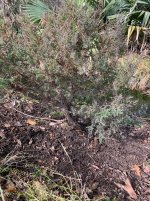





The Barber
Chumono
Had a really good haul of trees today, collected 10 total. One of my customers at the barbershop mentioned that he was interested in starting bonsai, so I let him tag along, and potted him up 2 trees we collected, an elm, and a hornbeam.
Found a spot where the beavers have been collecting trees for a long time it appears. Sadly we didn't discover the spot till about an hour and a half before dark, and had probably a 45 minute hike out of the area. My phone died right after we got there. There's more trees I have to go back and dig, there's a big curvy sweet gum that the beavers have pruned at least 4 times that has perfect taper, maybe a 5 inch trunk, 20 inches tall and nice movement to boot... here are the 2 trees I've potted so far.
American hornbeam, don't see trunks twisted like that around here often.


Slippery elm I believe.

Found a spot where the beavers have been collecting trees for a long time it appears. Sadly we didn't discover the spot till about an hour and a half before dark, and had probably a 45 minute hike out of the area. My phone died right after we got there. There's more trees I have to go back and dig, there's a big curvy sweet gum that the beavers have pruned at least 4 times that has perfect taper, maybe a 5 inch trunk, 20 inches tall and nice movement to boot... here are the 2 trees I've potted so far.
American hornbeam, don't see trunks twisted like that around here often.


Slippery elm I believe.

Cajunrider
Imperial Masterpiece
Similar threads
- Replies
- 11
- Views
- 320
- Replies
- 7
- Views
- 310
















